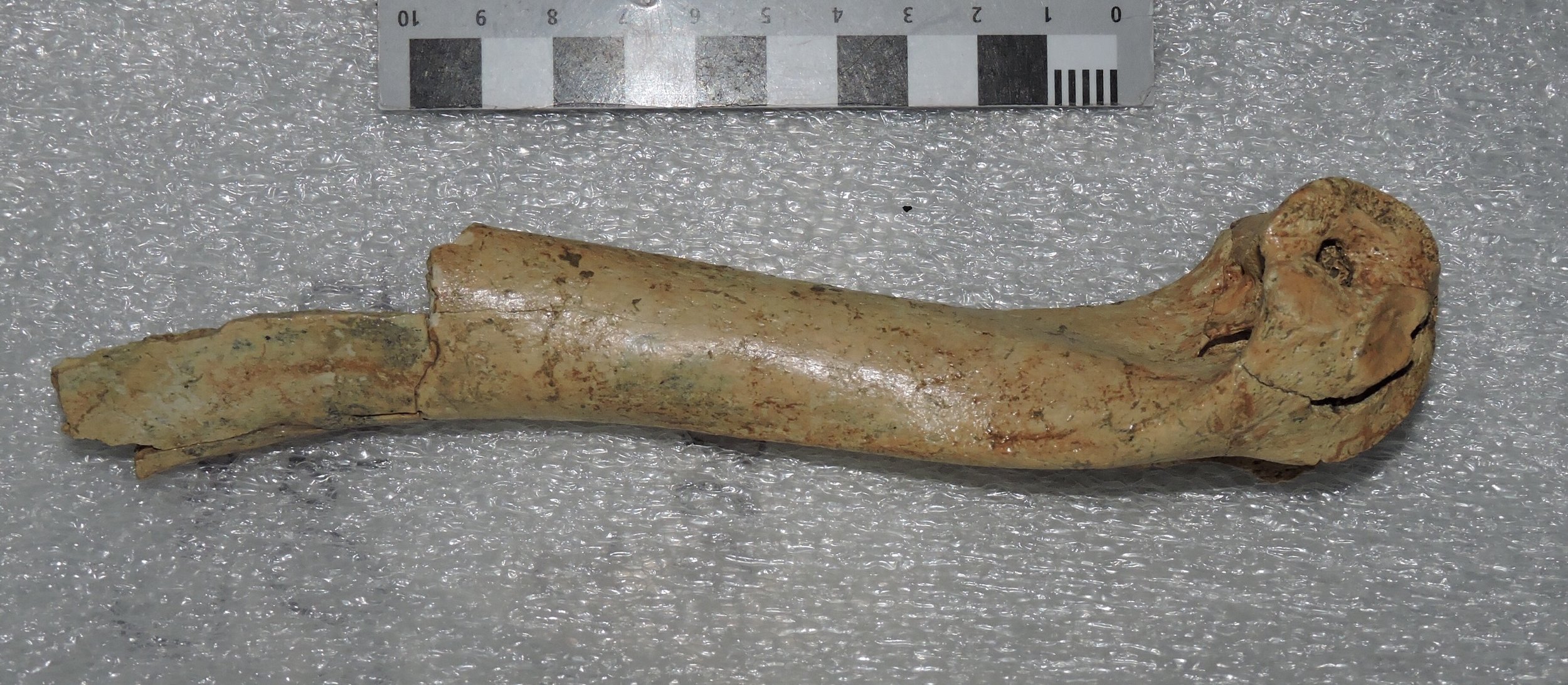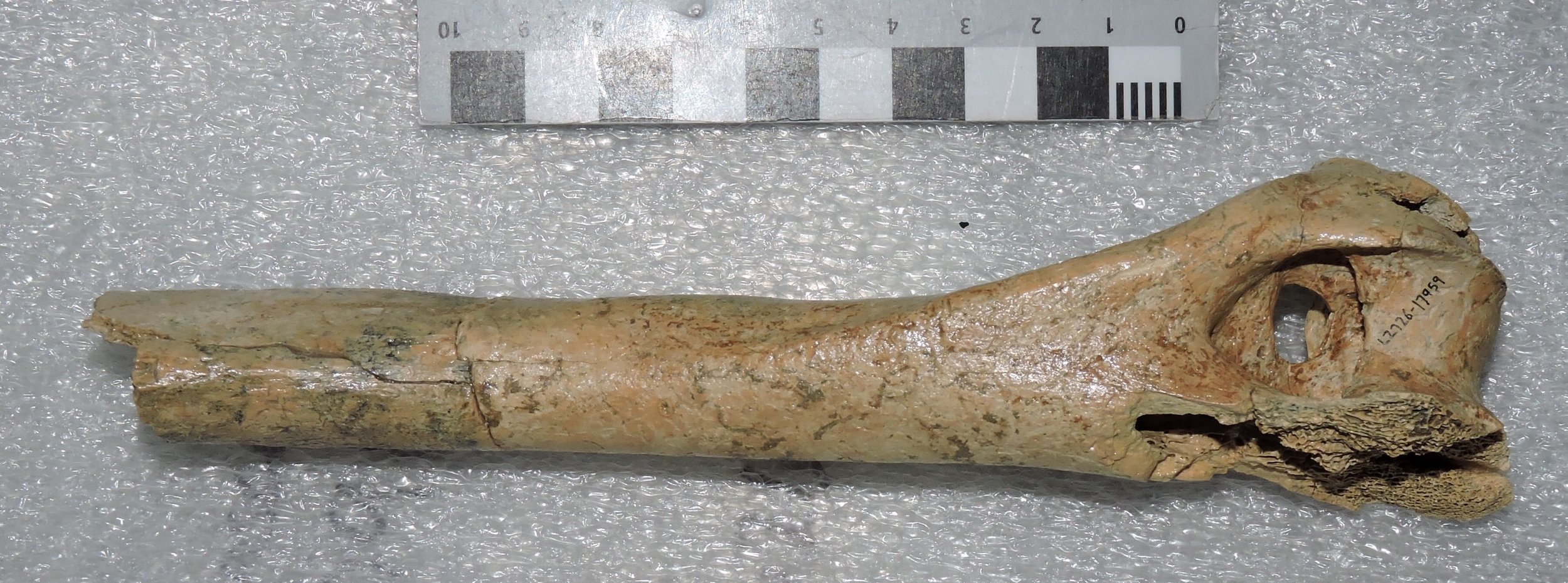 While over 200,000 fossils were found at Diamond Valley Lake, only a tiny percentage of the specimens represent carnivores. This is actually to be expected; in any stable ecosystem prey animals always greatly outnumber their predators and so normally prey animals should be much more common as fossils. There are exceptions, such as "predator traps" like we see at Rancho la Brea, but in general the rare predator/common prey breakdown at Diamond Valley Lake is what we expect to find.That said, there is actually a fairly diverse range of predators from Diamond Valley Lake, even if most of them are known only from isolated bones like as the one shown above.This is the right humerus (upper arm bone) from a canid, the dog family. It's shown above in anterior view, with the proximal end (towards the shoulder) on the left. The proximal half of the bone is actually missing, so we only have the distal half, including the elbow joint at the right end (the condyle). The round hole through the middle of the bone near the condyle is called the supratrochlear foramen. This is a common feature in dogs, but is rare or absent in most other groups, making it a useful identification feature.Below is the medial side of the same bone, showing the sinusoidal shape that is typical of the humerus in carnivores:
While over 200,000 fossils were found at Diamond Valley Lake, only a tiny percentage of the specimens represent carnivores. This is actually to be expected; in any stable ecosystem prey animals always greatly outnumber their predators and so normally prey animals should be much more common as fossils. There are exceptions, such as "predator traps" like we see at Rancho la Brea, but in general the rare predator/common prey breakdown at Diamond Valley Lake is what we expect to find.That said, there is actually a fairly diverse range of predators from Diamond Valley Lake, even if most of them are known only from isolated bones like as the one shown above.This is the right humerus (upper arm bone) from a canid, the dog family. It's shown above in anterior view, with the proximal end (towards the shoulder) on the left. The proximal half of the bone is actually missing, so we only have the distal half, including the elbow joint at the right end (the condyle). The round hole through the middle of the bone near the condyle is called the supratrochlear foramen. This is a common feature in dogs, but is rare or absent in most other groups, making it a useful identification feature.Below is the medial side of the same bone, showing the sinusoidal shape that is typical of the humerus in carnivores: Here's the posterior view:
Here's the posterior view: In this view the supratrochlear foramen is sitting in the bottom of a deep semi-circular depression, called the olecranon fossa. When the front leg is held straight, the olecranon process of the ulna (the "point" of the elbow) fits into this depression. This stabilizes the elbow and prevents the upper and lower arms from rotating in opposite directions along their long axes. To see how this works, hold your arm out straight, then rotate your arm like you're turning a screwdriver. Watch your elbow as you do this; you'll see that there's no rotation of the elbow at all, and that all the rotation is occurring either in the forearm and wrist, or at the shoulder.So, moving on from the anatomy, what kind of dog is this? This is actually a pretty large humerus by dog standards, and probably it's too large to be from a fox or a coyote (even the big Pleistocene coyotes). The distal end is damaged on its lateral side, but it looks like the bone was somewhere around 50-55 mm wide at the widest part of the distal end. At that size, this humerus is about right for either a small dire wolf (Canis dirus) or a large grey wolf (Canis lupus). There is other Diamond Valley Lake material that is pretty clearly from Canis dirus, but none that's definitively from Canis lupus (in fact, grey wolf fossils are extremely rare anywhere in California, if they're present at all), so a dire wolf is the more likely identification.
In this view the supratrochlear foramen is sitting in the bottom of a deep semi-circular depression, called the olecranon fossa. When the front leg is held straight, the olecranon process of the ulna (the "point" of the elbow) fits into this depression. This stabilizes the elbow and prevents the upper and lower arms from rotating in opposite directions along their long axes. To see how this works, hold your arm out straight, then rotate your arm like you're turning a screwdriver. Watch your elbow as you do this; you'll see that there's no rotation of the elbow at all, and that all the rotation is occurring either in the forearm and wrist, or at the shoulder.So, moving on from the anatomy, what kind of dog is this? This is actually a pretty large humerus by dog standards, and probably it's too large to be from a fox or a coyote (even the big Pleistocene coyotes). The distal end is damaged on its lateral side, but it looks like the bone was somewhere around 50-55 mm wide at the widest part of the distal end. At that size, this humerus is about right for either a small dire wolf (Canis dirus) or a large grey wolf (Canis lupus). There is other Diamond Valley Lake material that is pretty clearly from Canis dirus, but none that's definitively from Canis lupus (in fact, grey wolf fossils are extremely rare anywhere in California, if they're present at all), so a dire wolf is the more likely identification.
